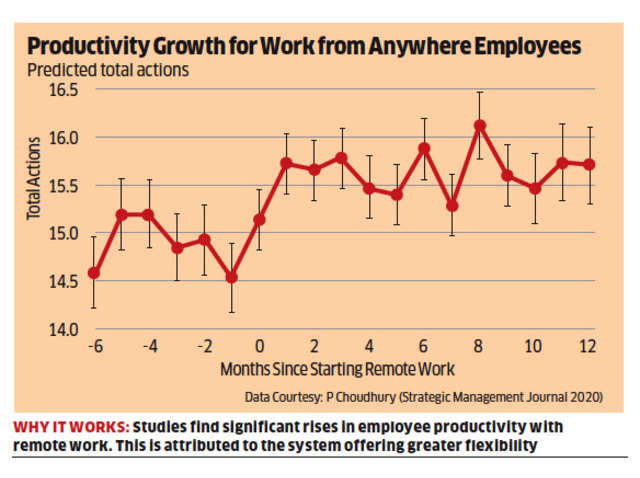![]()
Prithwiraj Choudhury teaches business administration at Harvard Business School. Speaking to Srijana Mitra Das, he discusses why work from anywhere will soon be the norm — and how managers need to rework trust and camaraderie:
Is work from anywhere here to stay even after the pandemic?
Well before the pandemic, some companies had already adopted this system — this included the US Patent and Trademark Office and cutting-edge remote start-ups. What the pandemic did is to accelerate this phenomenon by ten years. The acceptance of remote work by several companies globally is one of the few blessings of an otherwise incredibly hard time. Work from anywhere now applies across industries, from tech to banking, finance, and even industrial companies handling manufacturing or supply chain management. Companies leading the charge will be pioneers — they’ll be magnets for talent because remote work enables a company to attract the best. This will grow and be the future of work.
Is there a history to this?
The remote work phenomenon has many interesting episodical shocks. One of these was the oil price shock of the 1970s, which enabled several companies to think about remote work. But large-scale implementation happened in 2012 when the US federal government across departments — including agriculture, NASA and the US Patent Office — allowed remote work for employees.
What are its benefits for employees and companies?
The greatest benefit for the employee is that you have control over your time, which is called ‘temporal flexibility’ — you don’t have to commute, you can work in the day or at night depending on your personal style and you get geographic flexibility about where you want to live. Many employees may not want to live in a big city. They might opt to live in small towns, maybe closer to their parents. People can save more if they move to a smaller town, or they could choose to move to a better climate or a culturally preferred location.
For a company, with remote work, you can hire talent globally with ease. You don’t need to open a subsidiary in Kenya or Poland to tap local talent. And productivity rises — in the US Patent Office, productivity went up by 4.4% when people moved to work from anywhere. Employees felt more loyalty to the company for giving them such flexibility — they then exerted more effort.
Does this help women, given how they are facing a double shift of official and domestic work in the pandemic?
Significantly, the pandemic doesn’t represent normal times when schools, daycares and help will be available. Remote work actually suits women — many women forego career opportunities if these involve relocation which their family life constrains. Remote work helps with that. If a woman has security concerns about living in a certain town, this system helps with that too. And, often, mentoring opportunities can be very gender-biased in offices with mentors giving disproportionate time to men. In remote work, all it takes is for the mentor to share their screen — if you’re a trader and you have four junior people, once you share your screen, everyone gets equal access to what you’re working on. Mentorship is much more equal. And finally, remote work poses fewer risks like harassment.

With the rise of remote work, how should managers adapt?
This is organisational transformation — it is really a management challenge, not a technological one. The role of the manager is seminal here. Managers will need two behavioural changes — they should cease to measure direct reports based on how many hours you work. Productivity can’t be based on such inputs now. It will have to be based on the quality of your work. Managers also often just pick up the phone and call their direct report — but, with remote work, people will be in different time zones. You can’t have people attending team calls at midnight. A lot of work will have to be done asynchronously, on Slack channels or shared Google docs. The manager must trust that their direct report will respond at the first opportunity.
With remote work, can the line between work and leisure blur?
There are two ways to manage this. One is to reduce synchronous on-camera video calls. Zoom fatigue is very real — you can help by moving a large part of communication to asynchronous modes like a team portal, shared documents, etc. Secondly, you can have a dedicated team measuring employee wellness. A ‘head of remote’, for instance, measures the time an employee spends on camera — if I spend, say, 12 hours daily online, I’ll get a message from the wellness team, saying, you need to slow down. You should take breaks.
What could replace the camaraderie of the office floor?
Interestingly, earlier, we had office friends only on our floor. That can be changed with remote work — I’ve been advocating ‘virtual watercoolers’, a new way to socialise with people from work, based on an interest group or a de-stressing activity. These could be planned sessions with people randomly invited. You can create vibrant, mixed groups. People can begin new friendships, which they wouldn’t be able to in the physical office.
What about the daily office commute?
That will not be missed.
We are providing practical training (Labor Laws, Payroll, Salary Structure, PF-ESI Challan) and Labor Law, Payroll Consultant Service & more:
- HR-Generalist-Practical-Training: https://oneclik.in/hr-generalist-practical-training/ (PF, ESI, Bonus, Payroll & more)
- Labour Code | Labour Bill (Labour-Law-Practical-Training): https://oneclik.in/labour-law-practical-training/ (Factory, Contact Labor, Maternity Act & more)
- PF – ESI Consultant Service: https://oneclik.in/pf-esi-consultant-service/
- Labor Law, Compliance & HR – Payroll Management
- Advance Excel Practical Training
Get Latest HR, IR, Labor Law Updates, Case Studies & Regular Updates: (Join us on Social Media)
- Telegram Channel: “One Clik”
- Whatsapp Group: https://wa.me/919033016939
- Facebook: One Clik
- Linkedin: One Clik
- Instagram: oneclik_hr_management
- YouTube: One Clik

